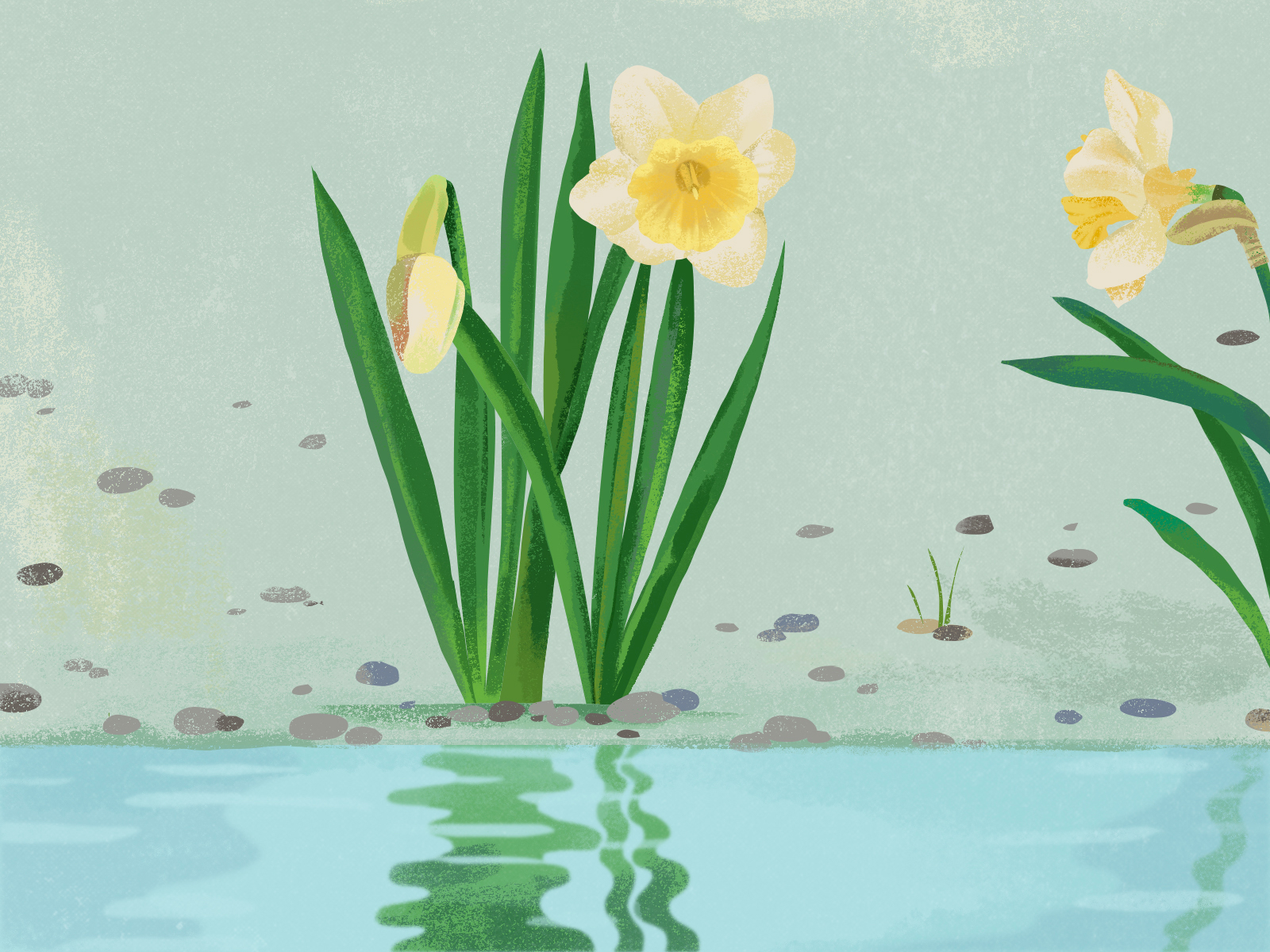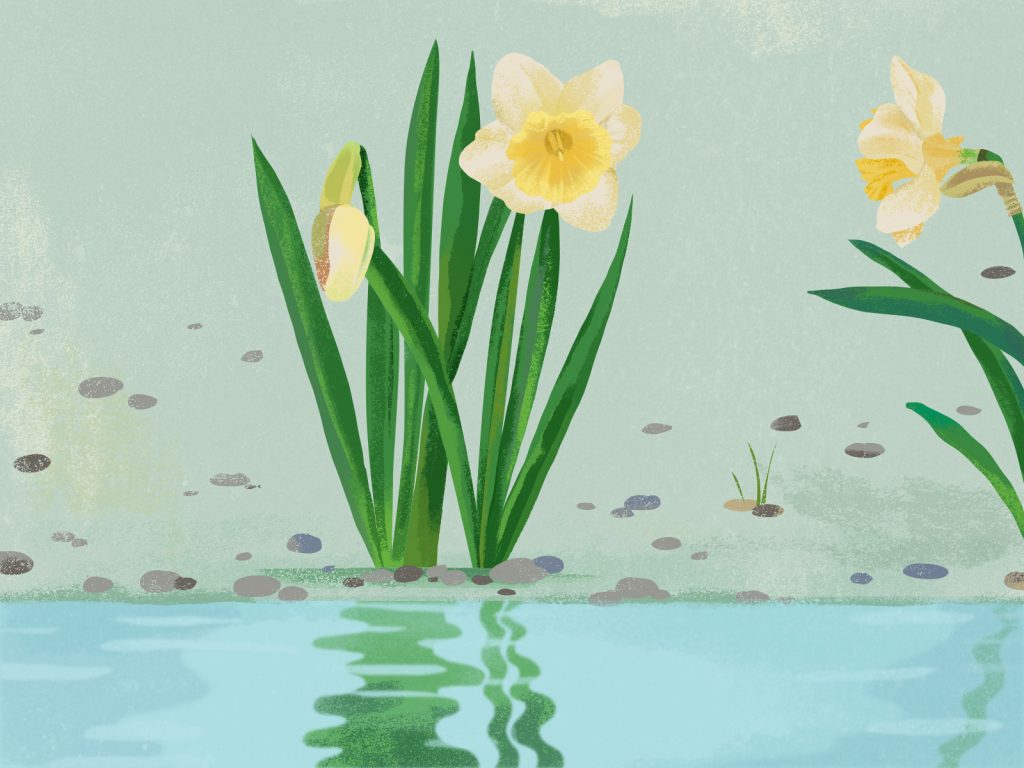Best of the Haiku Challenge (April 2023)
Announcing the winning poems from Tricycle’s monthly challenge The post Best of the Haiku Challenge (April 2023) appeared first on Tricycle: The Buddhist Review.

Announcing the winning poems from Tricycle’s monthly challenge
By Clark Strand May 25, 2023 Illustration by Jing Li
Illustration by Jing LiBecause haiku are so short, the most that a poet can do in any given poem is to suggest a “vector of meaning” for the reader to explore. If the vector is too broad, readers won’t know what the poem is about. If it is too narrow, they will quickly exhaust its resources and move on to another haiku. The trick is to invite readers to “linger” inside of a haiku, giving them enough space to wander about, but not so much that they feel lost in it. Each of the winning and honorable mention poems for last month’s challenge suggested a range of meanings for the reader to explore, as if wandering into a garden or a house.
Mat Osmond’s narcissi invite us to explore the value that things have in themselves, without recourse to human constructs. Nancy Winkler finds a humorous (and possibly satirical) coincidence in the species name ‘narcissus poeticus.’Jill Johnson finds the flower’s mythical namesake afraid to move, trapped by the stillness of his own reflection.
Congratulations to all! To read additional poems of merit from recent months, visit our Tricycle Haiku Challenge group on Facebook.
You can submit a haiku for the May challenge here.
***
WINNER:
Not needing to know
what this is for: narcissi
nodding in the rain
–Mat Osmond
In his 1906 novel Kusamakura (“Grass Pillow”), Natsume Soseki summed up the artistic lifestyle in a single sentence: “Putting it as a formula, I suppose you could say that an artist is a person who lives in the triangle which remains after the angle which we may call common sense has been removed from this four-cornered world.”
Since the novel’s protagonist spends his days wandering through the countryside in search of haiku, it seems likely that Soseki was referring specifically to the poet. The haiku poet lives in a “three-cornered world” from which the angle of utility has been removed. He doesn’t need to know what anything in that world is for—only the value that it has in and for itself.
Last month’s winning haiku is deceptively simple: the poet states that he doesn’t need to know the purpose of the narcissi nodding in the spring rain. He may find them beautiful, but he doesn’t say so. He seems unwilling even to say that. It isn’t clear at first what the poem is even about.
The word “this” is vague to the point of borderlessness. Is he talking about the flowers . . . the moment . . . or all of life itself? Whatever it is, it is bigger than the narcissi. Bigger even than the poet. And yet, the flowers remain the focus of the poem.
The genius of haiku lies in packing big meanings into small spaces. This is accomplished through the use of season words. A poet will zero in on one thing from the natural world as a way of revealing the soul of the cosmos. To William Blake, it meant:
To see a World in a Grain of Sand
And a Heaven in a Wild Flower
Hold Infinity in the palm of your hand
And Eternity in an hour
The poet has captured that experience without using words like Infinity or Eternity. The narcissi nodding their heads in the spring rain are saying “Yes!” . . . to everything, everywhere at once.
HONORABLE MENTIONS:
delighted to learn
‘narcissus poeticus’
is its species name
–Nancy Winkler
Narcissus knew this—
if he disturbed the water,
he would be alone.
–Jill Johnson
♦
You can find more on April’s season word, as well as relevant haiku tips, in last month’s challenge below:
Spring season word: “narcissus”
narcissus blossoms
the bent neck of a people
who cannot look up
I wrote this haiku in April of 2019, after passing six or seven people in a row on Park Avenue—all glued to their phones. I passed a stand of narcissus a few moments later and, noticing their “bent necks,” made the obvious connection.
Submit as many haiku as you wish that include the spring season word “narcissus.” Your poems must be written in three lines of 5, 7, and 5 syllables, respectively, and should focus on a single moment of time happening now.
Be straightforward in your description and try to limit your subject matter. Haiku are nearly always better when they don’t have too many ideas or images. So make your focus the season word and try to stay close to that.
REMEMBER: To qualify for the challenge, your haiku must be written in 5-7-5 syllables and include the word “narcissus.”
Haiku Tip: Trace the Subject to Its Origin
Although poets use season words in various ways when writing a haiku, the most time-honored use involves tracing a subject to its origin. This involves knowing the history of the word in question and using that knowledge to create a unique or compelling turn of thought.
Sometimes the origin of a season word is hidden in plain sight. An example would be the daisy, from the Old English dæges ēage (“day’s eye”), because it opens and closes with the sun. A haiku using daisy may or may not allude to the original meaning of the word, but a smart poet will keep that spirit of bright, cheerful optimism in mind.
The following poem, written by Takahama Kyoshi on April 30, 1936, offers a good example:
immediately
after I step on daisies
they get right back up
Daises are spring wildflowers that grow so prolifically that it is sometimes impossible to avoid stepping on them when crossing an open field. The poet makes no allusion to the “opening eye” of the day. Nevertheless, his daisies that “get right back up” after they have been stepped on convey a spirit of resilience and renewal.
Kyoshi was visiting Shakespeare’s birthplace at Stratford-on-Avon when he wrote his haiku and used the English word for the flower in his Japanese original. And so, added to the essential spirit of the season word is a little nod to the Bard who used the names of so many seasonal flowers in his plays.
Think of it this way: Haiku are shallow, but the season words are deep. If you want to craft a 17-syllable poem with reserves of meaning and nuance, trace the season word back to its origin and capture its spirit in words.
A note on narcissus: Although potted narcissus are forced to blossom from Christmas through February, true narcissus (called “daffodils” by many) appear outdoors in early spring. Varying in color from white to yellow, with a bent upper stem and a longish corona, or “trumpet,” they grow in full sun or partial shade and sometimes reach a height of two feet. The name originated in ancient Greece, where Nárkissos was a youthful hunter known for his great beauty. He refused the advances of every would-be lover, preferring to gaze at his own reflection in a pool of water. According to one myth, when Narcissus died, the flowers that grew by the water were given his name. Later, Pliny the Elder claimed that the plant had been named for the effect produced by its scent (narkao, “I grow numb”) and not the self-absorbed youth.
![]()
Thank you for subscribing to Tricycle! As a nonprofit, we depend on readers like you to keep Buddhist teachings and practices widely available.
This article is only for Subscribers!
Subscribe now to read this article and get immediate access to everything else.
Already a subscriber? Log in.

 Hollif
Hollif 
































